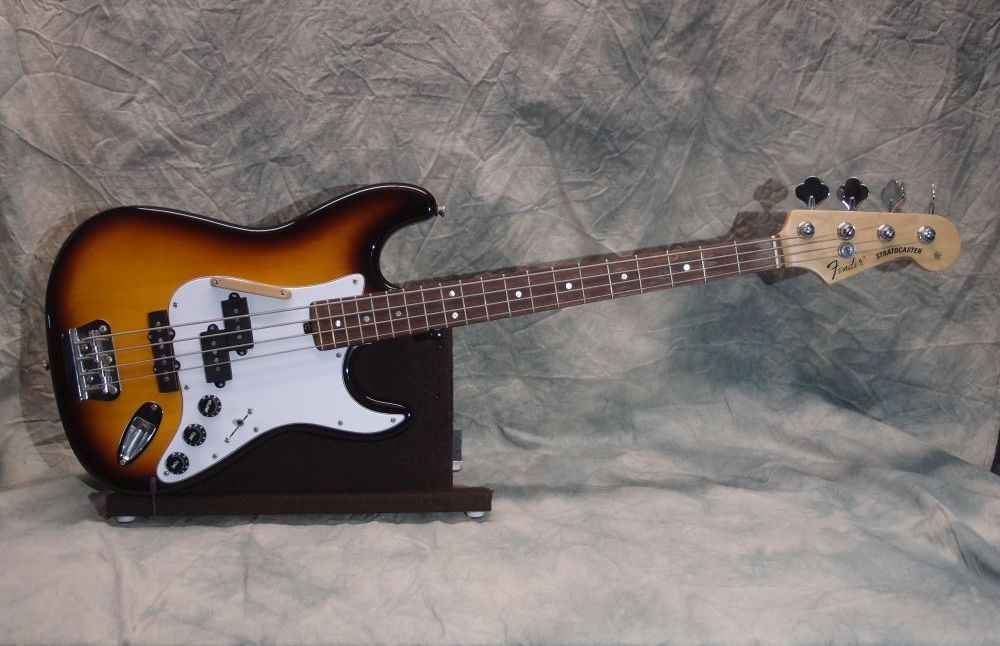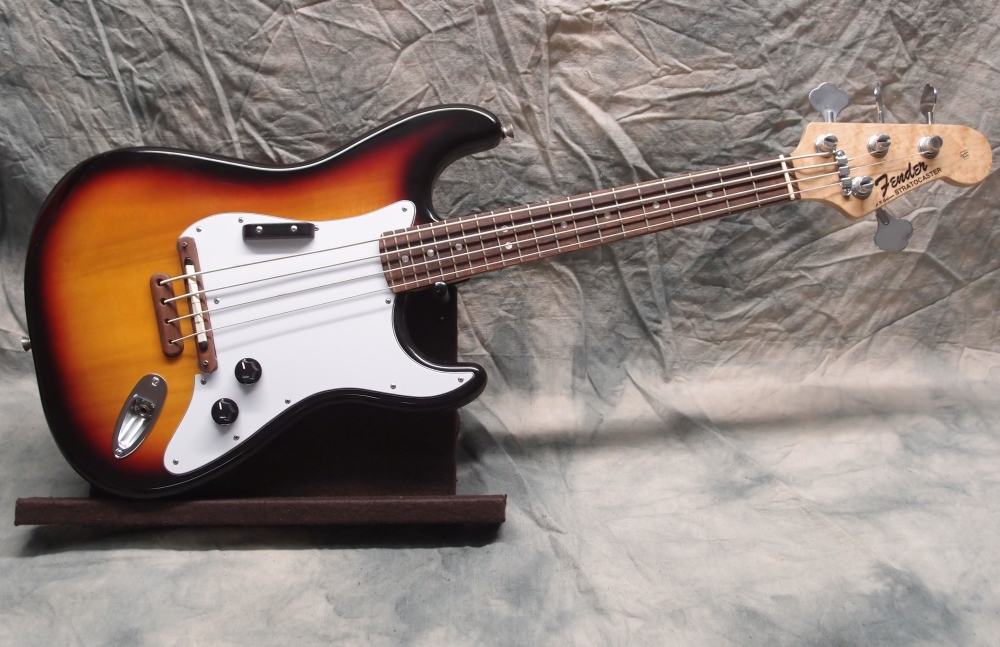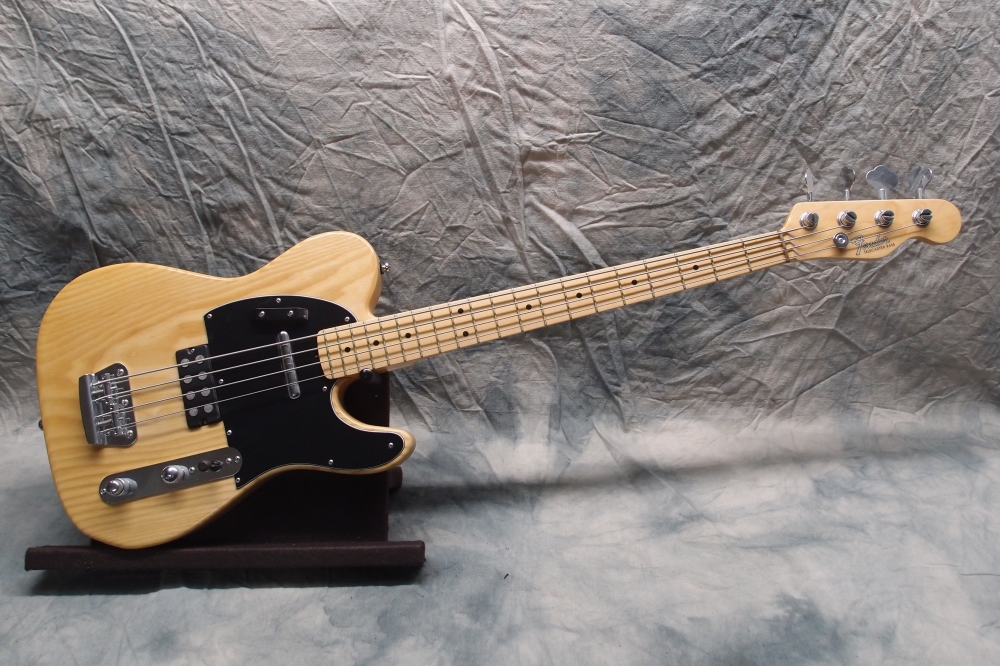Stratocaster Micro Bass 2 (2/2)

And the wiring is all done and verified. The first tone control is a pickup mode switch for the humbuckers - parallel/series/single coil. It switches all three pickups simultaneously; the different tones available are far more varied than what you can get with a standard mush knob. The second tone control is that. That's a couple of hours of skilled labor, you'll never find a setup like this on a factory guitar. Please don't critique my soldering, I know it ain't pretty, but it is solid, and some of the pieces were used already.
I handle the ground as part of the body. The bridge, shielding, and jack all collect together on a screw in the side of the control cavity, with a long black jumper to the pickguard. You'd need the screw in any case to pick up the shielding, so why not use it for more? The red output wire is equally long. This allows for removing and flipping the pickguard to work on it without having to break any connections, as in the picture. Also, the ground wire is on its own little blob of solder on the volume pot, so if it does need to be broken, the other grounds are not disturbed.
The pickup leads are uncut, to preserve proper phasing. I don't know why the big manufacturers haven't picked up on this, they could charge extra for it. ( It's exctly the kind of marketing bullsh!t they love. ) The pickup switch is standard parallel 5-way, actually the only part of the body's original wiring. With the 3-way mode switch and the 5-way pickup switch, there are 15 possible pickup configurations, of which 12 are humbucking. A pull-switch on the tone control would add six more, but enough is enough. I could also build a bass/treble control from a balance pot, but I find a bass control is kind of useless on a bass, it just strangles it. So I just went with the standard simple treble control.
The black output jack is temporary until I can get a nice bright chrome one. I don't have any strap buttons for this project either, I really wasn't expecting to do anything with this body. Next up is a full neck transplant from the other pico, which will get the spare neck and lighter strings.
I don't usually like humbuckers on a bass, but I like these. I think perhaps because they are so narrow - single-coil width - they give a more focused tone than a typically very wide bass humbucker, which always sound muddy, boomy, and overbearing to me. Jazz bass pickups are similarly narrow, while P-pickups are somewhat wider, but effectively single-coils. Musicman pickups are wide humbuckers, but wired in parallel, which changes their nature completely. These are actually guitar pickups, but they work great on a bass with narrow string spacing like this, or with standard string spacing as long as you stay away from the bridge. I wish they were made just a quarter of an inch wider - they would be awesome dedicated bass pickups. They are also much easier to install and adjust than traditional bass pickups.

Here is Pico bass #2, in the middle with three pickups. Pico #1 is sad at the left, missing a few parts that were donated to #2. On the right is the fretless that was originally a piccolo.
It was a complex series of valmorphanizations to get here. First, I decided that the piccolo was a waste, and made it into the really cool 30" fretless with a new neck. That left me with a spare 25" bass neck with no tuners. Then, I started messing around with the red body that I had no real plans for, and got it to an unexpectedly nice state, so I decided to do something with it. I took the entire neck off Pico #1 and installed it on the red body, creating Pico #2. Then I installed the spare neck on Pico #1, because I think that neck and body are better, and it made sense to mate them.
Along the way, I broke the .135 E string, and made a new .125 to replace it. I never liked the .135 - too stiff - the .125 plays much better. I could replace all the strings, but I see no point in it. I also did some experiments capo-ing a standard .105-50 set to 25" and then tuning EADG. That was much too sloppy for my taste. The current string set is .125 .105 .085 .065, and that works well enough. If I was to design a string set for 25" scale, I would probably use .120 .100 .080 .060, just a little lighter, but the current set works fine, and is easy to make from an off-the-shelf 5-string set. Anything in the ballpark of these values should work.
Unwinding a string to any length is easy. Put it on the guitar and figure out what length you need, or where you need to unwind to. Soak the inch above that point with Crazy Glue to fix it in place. Cut off the excess, then unwind the outer windings, but not the inner windings. Finally, smooth in the cut winding and Crazy Glue it down. I did this on the .125 and the .105, the rest of the strings are small enough to fit the posts unmodified. Once you can do this, you can make any kind of string you want. 25" half-rounds? No problem. The string that broke, broke at the bridge because I pulled on it too hard, my work held up just fine.
Setup was as expected. The neck took the shim I was expecting, based on the first Pico. That brought the action with range of the bridge adjustment. It is not as low as you might think, the extra-heavy strings require more space to do their shaking. Tuning and intonation are very touchy with such short heavy strings. The pickups are high output guitar humbuckers, and tend to overload when presented with the mass of the bass strings, so I dropped them almost all the way down. It is still very punchy. It takes a few minutes to reprogram your left hand for the 25 inch scale, and then it is a blast to play.
Pico #1 will eventually get put back together. Check out the bridge on Pico #2. I made that from a surplus Bronco plate and saddles scavenged from a 5-string bridge. It is a bit wide, I may someday shave down the inner saddles, but otherwise it works great. I also re-contoured the neck heel. It was originally a 22 fret neck, but the overhanging bit broke off and left a scar, and the shape was wrong anyway, so I belt-sanded it down, and it fits much better now. The pickups and the electronics all came from the parts box.
This is the end of my Strat experiments - I have no more bodies or necks remaining, and I think I've done just about every reasonable variation. Since I started several years ago, that includes eight Strat basses and one 12-string, a Telecaster bass, and three Jazzmaster basses. Let's see what some other folks come up with now. I've laid out all the particluars:
- body: Stratocaster from eBay, block tremolo hole
- neck: paddle head Strat from Eden
- tuners: compact sealed tuners for the guitar-sized headstock
- bridge: 18mm spacing, Bronco or Chinese from eBay
- strings: unwind a light 5-string set
- pickups: your choice, stock will work fine
You can build a Pico Strat Bass like this on your kitchen table with just hand tools. So get busy !!!
Later ...
I strung up the bare pico with some super-cheap strings from China that I was curious about. They're kind of dead-sounding, but the blame for that is not entirely on the strings. These ultra-short-scale basses lack the dynamics of long-scale or even normal short-scale basses. For example, sometimes I like to hammer the strings against the high frets with my right hand. Not holding notes like some players, just whacking them against the frets instead of plucking them. It gives a very percussive metallic sound, akin to thumb-slapping. But not on the picos, not the same at all.
I actually spent a while going back and forth between both picos and several other normal basses. They just don't have the same range of dynamic response. I think it is probably the heavy short strings that just don't respond. Those heavy short strings also make tuning very fussy - they change pitch very fast and require very small adjustments. They also seem to go out of tune faster than normal strings.
And finally, the subject turns to intonation. For probably all the same reasons they don't like to tune up, setting intonation on a pico is kind of a lost cause, especially the E string. I had to modify the bridge on one of them to get enough travel, and even then, however you decide to set the intonation, if you then try a different way, you'll find it is off. Eventually, you just settle for a happy medium that hopefully only the tuner can detect. ( Part of the problem was that when I spotted that bridge, it was for guitar strings. I could move it, but I don't want to go to the trouble.)
Between the two bridges in the picture above, I would recommend the Bronco for a pico bass. Even though the stock Bronco bridge has just two saddles, it has much greater adjustment travel, and that will prove to be more useful. Having four saddles is of little help if there is no right place to put them anyway. The Bronco bridge also does a better job of covering the Strat tremolo hole. The square bridge has very little travel, which means you better guess right before you screw it down.
The pico basses are an interesting experiment, and fun to play, at least for your left hand. But sound-wise, I find them lacking, and much prefer my 30" creations. I find little difference in tonal range between the 30s and full-scale instruments. As for playability, the 30s fit my hands as well as the picos, with none of the excessive stretching required on a long-scale. The 30s also have wonderful balance and overall feel, even the ones with long two-octave necks, because I planned them that way, with guitar-sized headstocks and lightweight tuners.



















Questions or Inquiries?
Just want to say Hello? Sign the .